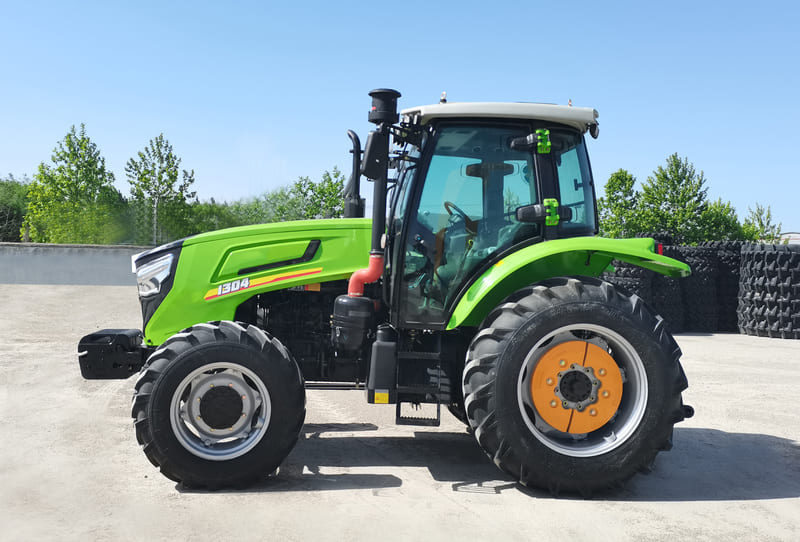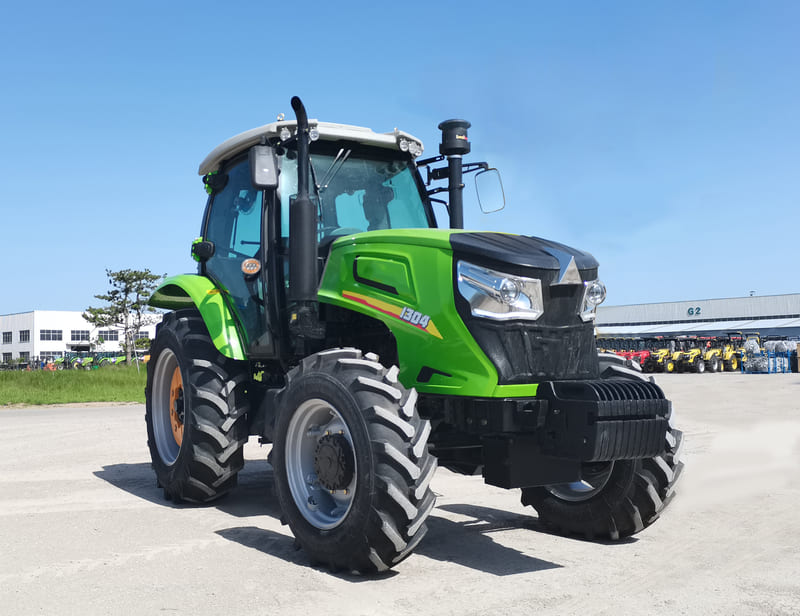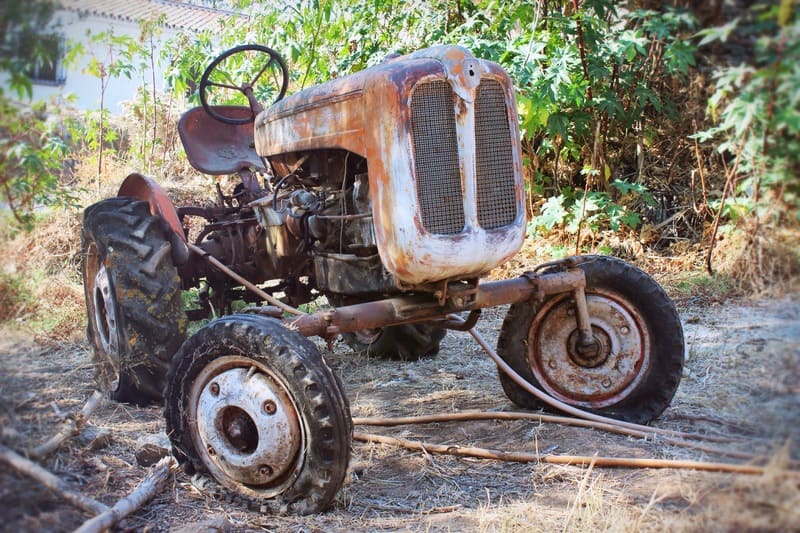When I had to decide between new and used tractors for my own fields, I realized that misjudging total costs and uptime can quickly undermine profit, especially under tough conditions.
A new farm tractor delivers better long-term ROI due to reliability, lower maintenance costs, enhanced technology, and full warranties. However, carefully sourced used tractors can offer short-term ROI advantages, particularly for price-sensitive buyers in emerging markets.
Choosing between new and used tractors isn’t just about the sticker price. Let’s break down capital outlay, maintenance, technology, and resale value for both options, focusing on what’s most relevant to commercial farming in tropical and developing regions.
1. What Are the Real Financing Challenges When Choosing New or Used Tractors?
The cost of upgrading equipment is confusing and overwhelming. Many fear hidden expenses or financing pitfalls. Careful evaluation of purchase options helps make smarter financial decisions and ensures smooth farm operations.
Financing a new tractor often offers better rates, warranties, and support, while used tractors are cheaper upfront but may require immediate repairs and carry higher borrowing challenges, especially in less developed markets.

Understanding Upfront Costs: New vs. Used Tractors
Buying a tractor is a big decision for anyone running a farm. The first question I ask myself is: do I have the capital for a new machine, or should I consider a used one? New tractors are expensive upfront. The price tag can be intimidating, but they often come with financing plans1 that make payments more manageable. Lenders see new equipment as lower risk. Because of this, they may offer better interest rates or flexible payment terms. Sometimes, manufacturers even work directly with lenders to provide solutions that fit the buyer’s cash flow.
For used tractors2, the situation changes. The price is the main attraction at first. Used tractors are often easier to buy for cash or with a smaller loan. However, the risks go up. I may have to pay for major repairs after the sale. Banks see used equipment as riskier because they might break down or lose value quickly. Getting a good loan is much harder. In some regions, banks won't even consider financing a used tractor, forcing buyers to turn to private loans, which often carry high interest rates and stricter terms.
Looking Beyond the Sticker Price
It is important to look beyond the initial price tag. When I compare new and used tractors, there are hidden costs and benefits:
| Factor | New Tractor | Used Tractor |
|---|---|---|
| Upfront Price | High | Lower |
| Financing Availability | Broad, low interest | Limited, higher interest |
| Warranty Coverage | Full, often extended | Limited or none |
| Maintenance Needs | Minimal at first | Often immediate or urgent |
| Technical Support | Extensive from dealer | Rare, depends on seller |
Buying new can reduce headaches. Warranties cover most early issues, and dealer support is strong3. Dealers train their technicians specifically for new models. I can reach out with questions and usually get quick answers backed by full documentation. This support prevents downtime and keeps my farm working smoothly.
If I buy used, things are different. Any technical help is usually up to me or a local mechanic. Manuals might not be available. It is harder to find original parts. If a breakdown happens, I could lose valuable time in the field while hunting for solutions.
The Long-Term Picture
It is essential to consider operating a tractor over several years4. Lower costs upfront with a used machine can become higher total costs due to repairs, lost time, and less reliable financing. If I need more predictability, a new tractor—despite its higher ticket price—may actually keep my finances healthier in the long run. The choice always comes back to how much risk I can handle and how much support I need for my operation to succeed.
New tractors typically offer better financing rates and warranties than used tractors.True
Lenders view new equipment as lower risk, often resulting in better interest rates and extended warranties.
Used tractors always come with comprehensive warranties that cover all repairs.False
Used tractors usually have limited or no warranty coverage, leading to potential unexpected repair costs.
2. How Do New Tractors Improve Reliability and Boost Operational Uptime?
Breakdowns during planting or harvest ruin schedules. In places with few repair shops, delays grow costly. Choosing new tractors reduces surprise failures with warranties and planned maintenance.
New tractors improve reliability and operational uptime by minimizing breakdown risks, offering comprehensive warranties, and providing predictable maintenance. This keeps farms running during crucial seasons, especially where technical support is limited.

The Real Cost of Downtime in Agriculture
When I worked in the field, one broken hose or hidden fault during harvest changed everything. Operation stopped. Waiting for repairs delayed everything. In rural regions with fewer technical experts, each hour of downtime cost more than money—it meant missed opportunities and anxious nights. Understanding why downtime5 hurts so much explains the push for reliable machinery.
Why Uptime Matters Most in Rural Regions
Farmers in areas with limited infrastructure face unique challenges. In small towns or remote regions, there are few repair shops. Tractor parts and skilled mechanics are often several days away by road. If a tractor breaks during peak planting or harvest, the whole process can stall. This puts crops at risk and profits on hold. New tractors offer stability by coming with manufacturer-backed warranties that cover essential systems like engines, hydraulics, and transmissions for years.
Warranty and Predictable Maintenance: The Safety Net
A new tractor’s warranty6 is a shield. If the engine stalls or a hydraulic pump fails within the first few years, the manufacturer covers the cost of repair or replacement. Unlike used tractors—where past wear and tear hide beneath fresh paint—new models start with clean records and tight quality control. Farmers get confidence and peace of mind knowing help is guaranteed.
This predictability enables planning. Scheduled maintenance cycles mean farmers know when service is needed, so they can plan around peak farming times. The table below highlights the differences between new and used tractors when it comes to reliability and uptime:
| Feature | New Tractor | Used Tractor |
|---|---|---|
| Warranty Coverage | 1–3 years (major components covered) | Often expired or limited |
| Hidden Fault Risk | Minimal | High (unless recently refurbished) |
| Maintenance Predictability | High, standard schedule | Unpredictable, depends on history |
| Uptime During Peak Seasons | Consistently high | At risk from sudden breakdowns |
| Support Availability | Manufacturer-backed | Third-party or self-arranged |
Hidden Faults and Unpredictable Breakdowns
Used tractors often arrive with a history that’s hard to trace. Even if they start strong, undetected problems can appear suddenly. A cracked valve, a degrading transmission, or a corroded hydraulic line might go unnoticed until it fails under stress. In tropical climates, where humidity speeds up corrosion and wear, this risk grows. One unplanned failure7 can disrupt the entire planting or harvesting rhythm. Unlike new tractors—where each part is fresh and inspected—used models place the burden of reliability on luck and constant vigilance.
Strategic Maintenance for Season-Long Performance
Scheduled maintenance is the backbone of consistent uptime. New tractors come with clear service intervals set by the manufacturer. When I followed these intervals, I noticed far fewer unexpected issues. Farm operations stayed on track, and I avoided costly last-minute repairs. In contrast, a used tractor’s schedule might not reflect real wear and tear, leading to urgent fixes and wasted time.
Final Thought
In agriculture, timing is everything. Each decision—especially about machinery—affects an entire season’s outcome. For farmers in regions with limited support, investing in reliability with a new tractor means fewer disruptions, more control, and a smoother path from seed to harvest.
New tractors come with manufacturer-backed warranties that cover major components.True
Warranties for new tractors typically include coverage for essential systems like engines, hydraulics, and transmissions, ensuring that repairs or replacements are managed by the manufacturer.
Used tractors generally have better reliability than new tractors because they have been previously tested.False
Used tractors often have hidden faults and a history of wear and tear, making their reliability less predictable than new tractors, which start fresh with inspections and quality control.
3. How Do Maintenance Costs and Parts Availability Impact Tractor Longevity?
Routine tractor upkeep seems simple—until hard-to-find parts and rising costs disrupt your operation. Frequent breakdowns and scarcity shortly turn a budget machine into a major liability.
Maintenance costs stay lower for newer tractors, while older equipment risks cost spikes. As machines age, locating specific replacement parts gets harder, especially for legacy models or in harsh climates, increasing downtime and expenses.

The Aging Tractor Dilemma: Expensive Fixes and Scarce Parts
Each year, I spend hours inspecting my older tractor. Small issues pop up: a cracked rubber hose, a tired clutch cable, brittle wiring under sun-heated panels. These problems seem minor, but tracking down replacement parts8 has become a regular challenge. Sometimes the wait for delivery runs into weeks. Each delay, I see fieldwork schedules shift. In my region, hot and humid weather accelerates this cycle. Rubber, plastics, and insulation degrade rapidly under this climate. Modern machines are not immune, but the effect is worse on older models.
Why Are Older Machines More Costly to Maintain?
Most people know that new tractors benefit from manufacturer support and generous warranties. That means supply chains prioritize replacement components, and you rarely wait long for shipments. Prices for standard parts hold steady. Dealers anticipate common fixes. Labor time stays predictable.
When equipment ages, parts catalogs shrink. Fewer vendors keep legacy items9 like obsolete clutch assemblies, outdated PTO shafts, or old electrical harnesses. As availability drops, prices go up. If you run a machine from the 1990s or earlier, you may even need to cannibalize another tractor—or pay a premium for custom fabrication. This puts pressure on managers to weigh the real cost of keeping one more season out of an older tractor.
The Accelerating Impact of Harsh Climates
I live in a region where high humidity is the norm. Tropical sun and rain tear apart seals and hoses. Electrical connectors corrode quickly. These conditions erase the life expectancy of rubber or synthetic parts. Sourcing replacements becomes a race: the parts you find need to withstand your local environment. For legacy tractors, finding such pieces gets more difficult each harvest.
Comparing Recurring Costs: New vs. Old Tractors
| Cost Factor | New Tractor | Old Tractor |
|---|---|---|
| Spare part availability | High | Low |
| Maintenance frequency | Low-to-moderate | Moderate-to-high |
| Part prices | Standardized | Inflated/variable |
| Downtime due to repairs | Minimal | Frequent, sometimes lengthy |
| Impact of climate | Manageable | Severe for aging components |
Why Supply Chains Matter for Longevity
New equipment profits from an active supply line. Distributors keep critical inventory and solutions in stock. But older models depend on global webs of specialty suppliers. If the dealer cannot source a part or must order overseas, the whole operation waits. Some farmers partner with others who run similar equipment to exchange spares or form buyer groups. That approach can lower costs, but requires time, knowledge, and sometimes luck.
Every season teaches me to factor both maintenance costs10 and parts availability11 into purchase decisions. Lower upfront prices on older tractors rarely outweigh the expense and frustration of constant repairs. In summary, the true cost to operate older machines keeps rising if supply chains12 do not support them, especially in harsh climates.
New tractors typically have better spare part availability than older models.True
As new tractors benefit from ongoing manufacturer support and active supply chains, parts are more readily available compared to older tractors where inventories are limited.
Older tractors have consistently lower maintenance costs compared to newer models.False
Older tractors often face higher maintenance costs due to scarce parts and frequent repairs, unlike newer models with standardized pricing and predictable maintenance.
4. How Does Depreciation Affect the Residual Value of New and Used Tractors?
Choosing between new and used tractors often creates uncertainty about long-term value. Depreciation can erode investment returns if misunderstood. Compare both options and learn effective strategies to protect your asset.
Depreciation quickly lowers a tractor’s value just after purchase, especially with new models, but upkeep and maintenance can slow further losses. Used tractors hold their value less, as field use accelerates wear and reduces resale potential.

Why Depreciation Happens Faster in New Tractors
Depreciation starts the moment a new tractor leaves the dealership. New tractors commonly lose a large percentage of their value within the first few years. This happens because new assets face a “first-use penalty13.” Buyers know that once a machine is put into service, it can no longer be marketed as new. The market adjusts by lowering the asset’s price to match its status.
Yet, after this initial sharp drop, a well-maintained new tractor loses value much slower. For example, in my own operation, I noticed my new-unit value dropped sharply in year one. However, careful maintenance, like timely oil changes and using only recommended attachments, steadied the market value over subsequent years.
The reason for this pattern is buyers have more confidence in a machine with a documented service history14. A tractor that has been meticulously cared for, with receipts and service logs, will always command a premium over one with an uncertain past.
Used Tractors: Short-Term Gains, Long-Term Considerations
Used tractors, on the other hand, come with some advantages. Their purchase price already reflects initial depreciation, which means buyers can enjoy good return on investment15 in the short term. If I buy a reputable used tractor, I avoid that first steep drop. This strategy suits those who want low upfront costs or plan to sell the asset after a few seasons.
However, used units accumulate hours and wear in harsh field environments. Even reputable suppliers cannot turn back the clock on wear-and-tear, so these tractors usually fetch a lower resale value at the next sale.
Comparing Long-Term Value: New vs. Used
| Tractor Type | Initial Depreciation Rate | Resale Value (After 5 Years) | Key Factors |
|---|---|---|---|
| New | High (30–40%) | Retain value longer | Maintenance, history |
| Used | Lower (10–20%) | Reduced due to heavy use | Condition, supplier |
Choosing the right balance depends on your business goals. I advise clients aiming for maximum long-term returns16 to invest in newer models if they can commit to rigorous maintenance routines17. Owners able to provide complete histories, like service records, see better offers when it is time to sell.
Meanwhile, if cash flow is tight or short-term ROI is most important, a quality used tractor18 from a trusted supplier might be best. The key is to inspect machinery carefully, prioritize units that were clearly well-kept, and be honest about the realities of future value.
The Role of Documentation and Condition
Documenting every major maintenance event keeps your asset’s value higher. Buyers will pay more for proof that a tractor received prompt repairs and proper servicing. For example, during resale, I presented a record book of every service hour and upgrade made to my tractor, resulting in a much higher offer compared to local market averages.
In summary, depreciation unavoidably impacts both new and used tractor investments. Your approach to maintenance, documentation, and honest evaluation of use case will determine just how much value your equipment retains when it’s time to sell.
Depreciation causes new tractors to lose a significant portion of their value shortly after purchase.True
New tractors typically experience rapid depreciation, losing a large percentage of their value within the first few years due to the 'first-use penalty.'
Used tractors do not depreciate in value.False
Used tractors do depreciate, but at a slower rate compared to new tractors, and their resale value is affected by wear and tear from prior use.
5. How Do New Tractor Technologies Improve Farm Efficiency and Sustainability?
Many farms struggle with outdated machinery that wastes fuel and time. When rainfall patterns shift or new crops are tried, older tractors fall short. Upgrading solves these problems.
New tractor technologies boost efficiency, reduce fuel use, and help farms meet today’s sustainability demands through features like precision GPS, high-horsepower engines, and improved weather resilience.

Powering Productivity: Engine Advancements and Precision Tools
In my years on the farm, I noticed old tractors spent more time refueling than working. New models change everything. They have higher-horsepower engines19 that use less fuel for the same or even more work. With the right tractor, I can cover more ground faster, even on rough fields. Smaller and mid-sized farms now use these technologies, not just the big ones.
Precision farming tools20 are another major shift. GPS steering21 is a game-changer. I remember marking rows by hand—now, auto-steering keeps every line perfect. This reduces overlap, so I save on seeds, fuel, and fertilizer. Telemetry tools help track machine health, fuel levels, and maintenance reminders. This down-to-earth technology keeps tractors running when they’re needed most.
| Tractor Feature | Efficiency Benefit | Sustainability Impact |
|---|---|---|
| High-horsepower engine | More work in less time, less fuel | Lowers emissions |
| GPS Steering | Precise operation, less overlap | Cuts input waste |
| Telematics | Monitors health, prevents breakdowns | Prolongs equipment lifespan |
| Emission Compliance | Meets latest eco standards | Cleaner air and water |
| Durability | Handles harsh weather, longer life | Reduces replacements |
Emissions and Sustainability: Meeting Modern Standards
Modern tractors do more than just work efficiently. They need to meet strict emission standards22. I saw these changes come when new regulations arrived. Engines now trap more pollutants and use better filters. This helps farms, both in big economies and in places with fragile ecosystems. Cleaner exhaust means safer air for me, my family, and workers in the field. It also meets buyers’ demands for responsible agriculture—a trend I cannot ignore.
These models don’t back down from the weather either. In tropical regions, machines must keep running in rain or heat. The latest tractors are sealed better and can operate in muddy, flooded fields. I’ve seen tractors now support a wider mix of implements. This lets me shift from rice to vegetables or sugarcane with the same base machine. I produce more per hectare and waste less.
Real-World Impact: Adapting to Diverse Settings
Every farm is different. In places where advanced tech seems out of reach, newer machines still bring big changes. Local teams can use GPS-linked devices23 to track yield or water use. Even in a basic setup, telematics show when parts need fixing. Fewer breakdowns mean harvests come in on time.
For larger farms, integrating all these tools matters. Matching powerful engines with mapping software helps optimize every operation during busy seasons. It reduces costs and grows more with less repeated effort. I’ve found that sustainability24 isn’t just a distant goal—it’s now part of every decision made before a new tractor rolls onto the field.
Farmers who invest in newer tractor technologies see these gains: lower fuel bills, healthier fields, and steady output—even as seasons change. These changes start simple: one navigation screen, a quieter engine, a day saved. But as new features add up, the farm strengthens against future challenges, while meeting stricter global expectations.
New tractor technologies improve farm efficiency and reduce fuel use.True
Modern tractors utilize high-horsepower engines and GPS technology which significantly enhance operational efficiency and decrease fuel consumption.
Older tractors provide better fuel efficiency compared to newer models.False
Older tractors tend to waste more fuel and are not equipped with modern efficiency technologies, making them less economical compared to newer models.
6. How Can Equipment Distributors Maximize Client ROI Through Informed Tractor Model Selection?
Choosing the right tractor model can overwhelm buyers. Missteps risk costly downtimes and poor productivity. Strategic recommendations tailored to each client’s situation can safeguard long-term value.
Distributors maximize client ROI by matching model selection to the buyer’s technical skills, local support infrastructure, and financial factors. Transparent sourcing, clear refurbishment protocols, and total cost-of-ownership (TCO) comparisons guide the process for optimal, sustainable results.

Understanding Client Profiles: Why Literacy and Local Support Matter
Choosing between new and used machinery goes beyond the sticker price. I have seen clients get caught off guard when upfront savings turn into recurring headaches. One major issue arises when end-users receive equipment far more advanced, or in worse shape, than they can maintain. This mismatch can happen if their technical literacy25 or access to after-sales support26 is not considered.
When I advise buyers, I first assess their operational know-how: Do they have in-house technicians or trusted local repair shops? New models typically require less maintenance and offer better dealer support. This is crucial for remote or growing markets. Used tractors can make sense for experienced operators with solid mechanical skills, where service records are clear and parts are available locally.
Sourcing with Confidence: The Importance of Transparency
Blindly acquiring used machines carries risk. I always push for clear service histories27 and proper refurbishment protocols from suppliers. Machines with transparent records allow buyers to predict reliability, plan maintenance, and reduce the risk of sudden breakdowns.
| Sourcing Factor | New Model | Used Model |
|---|---|---|
| Service Record Transparency | Not needed; factory-made | Essential; must be clear and comprehensive |
| Refurbishment | Not relevant | Must follow documented guidelines |
| Warranty | Standard | Depends on supplier; often limited |
| Support | Robust dealer network | Variable; often weaker |
Beyond Price: Comparing Total Cost of Ownership (TCO)
Price-sensitive buyers often gravitate toward lower purchase costs on used machines. Yet, TCO often tells a different story. Maintenance frequency, unexpected downtime, and spare parts all carry hidden costs. I help clients run side-by-side TCO comparisons. For many, the reliability and reduced downtime of a new machine outweighs initial savings.
Strategic Guidance for New and Growing Markets
Building trust is a top concern in new or rapidly expanding markets. When support systems and repair shops are scarce, I recommend prioritizing new equipment. This approach minimizes risk and fosters brand loyalty28. Used models can fill short-term needs for those with budget limits, but only when the infrastructure supports it.
Selecting the Best Fit: Bringing It All Together
Strategic model selection is not a one-size-fits-all task. I have watched clients thrive by aligning purchase decisions with their unique capabilities and market challenges. Careful distributor guidance ensures the best return on every investment, protecting growers and businesses alike.
Distributors maximize client ROI by aligning tractor model selection with buyers' skills and local support.True
Matching tractor models to clients' technical skills and support infrastructure enhances ROI and reduces downtime.
Choosing a tractor model solely based on the lowest purchase price is the best strategy for maximizing ROI.False
Focusing only on price ignores critical factors like maintenance costs, technical compatibility, and long-term reliability, which affect overall ROI.
-
Exploring financing options can help you manage payments better and find the best deal for your new tractor purchase. ↩
-
Learning about the advantages and disadvantages of used tractors can help you make a more informed buying decision. ↩
-
This link will provide insights into the advantages of dealer support, ensuring you make an informed decision when purchasing a tractor. ↩
-
Understanding long-term operation can help you make better financial decisions regarding tractor purchases and maintenance. ↩
-
Understanding the costs associated with downtime can help farmers make informed decisions about their operations and investments. ↩
-
Learning about tractor warranties can provide insights into how they protect investments and ensure reliable performance in agriculture. ↩
-
Exploring the causes of unplanned failures can help you implement strategies to minimize risks and enhance operational efficiency. ↩
-
Explore this link to find reliable suppliers for hard-to-find replacement parts, ensuring your tractor stays operational longer. ↩
-
Discover resources that specialize in legacy items, helping you maintain your older tractor efficiently and cost-effectively. ↩
-
Learning about maintenance costs can help you make informed decisions when purchasing and operating equipment. ↩
-
Exploring this topic can provide insights into the critical role of parts availability in reducing downtime and repair costs. ↩
-
Understanding the significance of supply chains can enhance your knowledge of operational efficiency and cost management. ↩
-
Understanding the first-use penalty can help you make informed decisions when purchasing new equipment, ensuring better investment outcomes. ↩
-
Exploring the impact of documented service history can guide you in maintaining your tractor's value and maximizing your investment. ↩
-
Learning about ROI in used tractors can help you strategize your purchases for better financial outcomes in farming operations. ↩
-
Exploring this resource will provide insights into maximizing your investment strategy for better financial outcomes. ↩
-
Understanding proper maintenance routines can significantly enhance the longevity and value of your tractor investment. ↩
-
This link will guide you on selecting the best used tractors, ensuring you make a wise investment decision. ↩
-
Explore how higher-horsepower engines can enhance efficiency and productivity on farms, making your work easier and more effective. ↩
-
Discover the latest innovations in precision farming tools that can revolutionize your farming practices and increase yields. ↩
-
Learn how GPS steering technology can optimize your farming operations, saving time and resources while improving accuracy. ↩
-
Understanding the latest emission standards is crucial for farmers to ensure compliance and promote sustainable practices in agriculture. ↩
-
Exploring how GPS technology enhances farming can provide insights into optimizing yield and resource management on your farm. ↩
-
Learning about sustainability practices can help farmers make informed decisions that benefit both their operations and the environment. ↩
-
Understanding technical literacy is crucial for effective machinery maintenance and can prevent costly mistakes. Explore this link to learn more. ↩
-
After-sales support can significantly influence the longevity and efficiency of machinery. Discover why it's essential for buyers. ↩
-
Service histories provide insights into a machine's reliability and maintenance needs, helping buyers make informed decisions. Check this out for more details. ↩
-
Learning about brand loyalty strategies can help businesses build trust and retain customers in competitive environments. ↩




